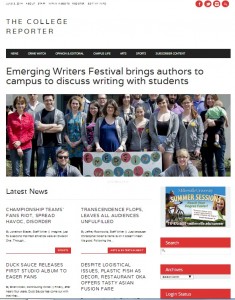Economics is a driving force in the digital only transition
By Miriam Ascarelli
New Jersey Institute of Technology
Two words: Digital first.
That was the trend of this 2013-2014 school year as a parade of student newspapers from the University of Missouri Maneater to The Daily Egyptian at Southern Illinois University Carbondale announced plans to scale back print publication days and ramp up their digital presences.
For some newspapers scaling back on print editions, the changes were part of a proactive strategy to stay ahead of the iGeneration, which already lives on the web, according to Bryan Murley, an associate professor of new and emerging media at Eastern Illinois University. But for others, Murley said, digital-first was an imperative motivated by a double whammy: declining ad revenue as national advertisers use social media instead of print ads to target college students and declining print readership as indicated by too many newspapers remaining on racks.
How these configurations will play out is anyone’s guess, but what’s getting considerably less attention is a move by some college news organization to eliminate print altogether, reinventing themselves as digital-only publications.
Although a precise tally of formerly print publications that are now digital-only doesn’t exist, Murley, who has been tracking such changes on his Innovation in College Media blog, doesn’t think there are more than 20. (Help us crowd source a more complete list by clicking here.)
One of the first schools to shed its print clothing was the Savannah College of Art and Design, which, in 2008 transformed the weekly publications at its Savannah and Atlanta campuses into digital-only publications.
Since then, the Savannah College of Art and Design has been joined by such schools as Malone University, a private Christian school in Canton, Ohio, whose student newspaper, The Aviso, went online-only in 2009, and Flagler College, a private liberal arts college in St. Augustine, Fla., where the student newspaper, The Gargoyle,has been digital-only since 2010.
Could online-only be the future? It’s hard to know, but as budgets continue to tighten, what was unimaginable only a few years ago is now part of the conversation, especially for smaller newspapers that don’t bring in a lot of ad revenue and therefore depend on student fees to pay the bills.
What follows is a look at two student newspapers that have gone digital-only in the last two years: The College Reporter at Franklin & Marshall, a small liberal arts college with 2,300 students in Lancaster, Penn., and The Spokesman at Morgan State University, a historically black urban university in Baltimore with an enrollment of more than 8,000 students, many of whom work full time.
Is there a learning curve? Yes. As the experiences at both schools reveal, going digital-only is more than just posting stories. It requires a do-it-yourself mindset and a willingness to experiment to find out what works. Indeed, one of the biggest challenges is developing a strategy to build an audience so that student work doesn’t get lost in the constant stream of Internet noise.
And yet, what also comes across in interviews with people from both schools is a sense of excitement. As Karen Houppert, the faculty adviser to The Morgan State Spokesman, noted, the fact that stories can be posted quickly and students can almost immediately see how their audience is responding has been so empowering that she can’t imagine The Spokesman going back to print.
Economics = driver
In both cases, the decision to go digital-only was partially driven by economics.
 At Franklin & Marshall, the student editorial board opted to go digital-only after looking at the bottom line. The paper had accrued about $3,000 in debt, and the e-board was forced to ask the college for financial assistance, said Justin Kozloski, who served as co-editor-in-chief through the digital rollout in in February.
At Franklin & Marshall, the student editorial board opted to go digital-only after looking at the bottom line. The paper had accrued about $3,000 in debt, and the e-board was forced to ask the college for financial assistance, said Justin Kozloski, who served as co-editor-in-chief through the digital rollout in in February.
The subsidy, Kozloski said, was seen as a potential threat to the paper’s editorial independence. The paper is housed on campus and relies on the school’s Office of College Programs to maintain its books, but it does not have an official adviser and does not receive student fees, which are points of pride among students, according to Kozloski. No one on the staff is paid.
“Financially it became too much of a burden,’’ said Alanna Koehler, who has been working out the kinks of the fully digital platform since taking the co-editor-in-chief reins in March. “We didn’t have the ad and subscription revenue to cover it.”
Earlier iterations of a digital edition, she said, never really gained traction, in part, because that paper’s staff of 15 to 20 students spent so much time on the print product that digital became an afterthought. “It was haphazardly updated. It was not really what we put our time and effort on,” she said.
Added Kozloski, her predecessor: “It’s really sort of hard to do both unless you have large staffs. Trying to balance both is not sustainable.’’
So students set to work.
Undeterred by her lack of experience with web design, Kozloski’s co-editor, Sloane Markley, built a new web site using a premium Word Press theme. On Jan. 27, students put the last print edition of The College Reporter to bed, and on Feb. 10, they were up and running as a digital start-up.
Under the new business model, students update the newly-designed website with new stories every Tuesday during the academic term and breaking news as it occurs. They also produce an 11 to 12-page PDF version of the paper that is emailed weekly to all students and faculty.
The savings? It did cost $800 a week to print 500 copies of a 12-page newsprint publication that included four full-color pages.Now the operational budget is $300 a year, which covers web hosting, office supplies and promotional activities.
The Morgan State backstory

At Morgan State, The Spokesman went digital in January 2013 as part of the overall vision of USA Today columnist DeWayne Wickham, who had just stepped into his role as the first dean of the university’s new School of Global Journalism and Communications, said Perry Sweeper, director of student media. Not only was online-only in sync with the school’s goal of preparing students for jobs in the 21st Century, it also allowed for an end-run around the production bottlenecks.
“It was for cost, productivity and not having to go through the process of – print – going to printer getting back to us, transporting papers to readers,’’ Sweeper said. “Now on the web, we can do it right away. No production necessary.’’
The shift coincided with a ramping up of journalism instruction overall. Under Wickham’s leadership, new instructors with experience in the working press were added to faculty ranks, staffing in the Office of Student Media increased from one person to three and the school acquired a $250,000 grant from the Knight Foundation to develop a student-staffed news service that will cover four nearby communities, Sweeper said.
The impact has been significant, according to Sweeper.
 Where students in years past had struggled to produce enough content to publish a paper every week (and sometimes only once a month), under the new model, content, which is produced by students on the newspaper staff as well as students in journalism classes, goes up on the web site two to three times a week, and sometimes even more frequently.
Where students in years past had struggled to produce enough content to publish a paper every week (and sometimes only once a month), under the new model, content, which is produced by students on the newspaper staff as well as students in journalism classes, goes up on the web site two to three times a week, and sometimes even more frequently.
“In the beginning of the semester, students are excited about everything so sometimes we get updates every day,’’ Sweeper said.
Student participation has doubled from 10 to about 20. If one also factors in students in journalism classes who are contributing work, the overall numbers have tripled, according to Sweeper.
The quality of content has also bumped up. “It’s more intellectual,’’ Sweeper said.
That assertion is quickly borne out by a quick perusal of the site. During the last week of May, the homepage featured a profile of a gay-friendly church in Washington D.C.; an overview of the criticisms of President Obama’s My Brothers’ Keeper Initiative, coverage of a rally in support of the kidnapped Nigerian school girls that included two videos and a slide show; and a moving personal essay in which the author revealed that her father was born after her grandmother had been raped by a family friend.
As for price, the web site costs about $1,000 a year to maintain, a stark contrast to the $1,000 it cost for each print run, Sweeper said.
MSU student writers are all volunteers, but the editor-in-chief and the managing editor receive a stipend of $10 an hour for about 20 hours a week of work. However, Sweeper anticipates there will be some kind of compensation for writers come fall. It will come from the money that has been freed up as a result of no longer having to pay to print the newspaper, he said.
Students: new medium, new mindset

Students may be addicted to their smart phones, but Koehler as well as Jada Vanderpool, her counterpart at MSU, said it was hard for them to give up print. “There’s nothing like having ink on your hands and having a print product you can hold and distribute every week,’’ Koehler said.
Added Vanderpool, who served as editor-in-chief of The Spokesman during the first semester of its digital-only incarnation: “It was definitely different. It required more ways of thinking of how to reach students. We had to be more creative and more strategic about how we decided to reach the students.’’
For example, Vanderpool said, on the day the digital incarnation was unveiled, the staff held a launch party with the student radio station (it was staging a comeback) in the student canteen to show off the new product and interview students about what they wanted to see in the newspaper. “Instead of walking around with the paper, we were walking around with our laptops,’’ she said.
At Franklin & Marshall, students promoted the digital shift via posters, word of mouth, and a large social media push. “We took to Facebook, Twitter, and Instagram to gain followers and prompt our readers to subscribe to our website,’’ Koehler said.
Koehler said the executive board had expected backlash—especially from parents and trustees. And while a few people expressed concerns, “most people were very pro-digital,’’ she said. There was also an overwhelmingly positive response to the weekly pdfs, she said.
As for students, they seem engaged with the product, she said. As of late May, the website had 362 registered users; the average website page views/day during the academic term were 453, with a high of 1,500, she said.
Other virtues: Students love to share and comment on stories, and staff are finding campus newsmakers are more willing to talk with them.
Has the new medium affected content?
In some areas, yes, Koehler said.
Opinion and editorial pieces, she noted, now have a less formal tone, and sound more blog-like. As for features, the staff is more aware of tailoring coverage to readers’ interests in the hopes of getting more hits.
In terms of news, Koehler said she catches herself using a more informal tone when she types stories directly into the paper’s WordPress site—but then has to correct herself. Editing, too, has been impacted.
“It makes me more scrutinizing of the writing than I was in print,’’ Koehler said. “Because it is more public, I want it to be as perfect as possible.’’
Vanderpool has similar observations. She said stories have become more playful, and the polls, videos and photos have created a visual aesthetic that appeals to students. The shorter turn-around also helps motivate students to get the stories done and posted, and, thanks to the immediacy of the medium, staffers no longer worry about articles becoming outdated before they see the light of day.
As an example, Vanderpool cited a story that was written in March about whether a candidate for the Miss Morgan contest had been wrongfully disqualified. The piece was up within days and got some 400 hits in one day. “Because we were online, the editor was able to post it up fairly quickly and post it up on her social media,’’ Vanderpool said.
The fact that work is easier to share has also been a motivating factor as has been the fact that one can Google oneself. “For me, that was cool,’’ she said. “It was just cool to know that other people could see it too.’’
Going digital has also strengthened her hand in the job market.
“In just about every internship they have wanted me to somehow help with web production,’’ said Vanderpool, who has interned with The Baltimore Sun and the Amsterdam News. ‘’Being familiar with WordPress it made it easier for when I went to internships.’’
What’s next?
At Morgan State, just getting the site up and going has been the priority for the last two years, so promoting the site and selling ads took a backseat, Sweeper and Houpper said. But this summer, an ongoing conversation about how to build audience and boost the ad base is definitely on the agenda.
“We are trying to get the word out now about being digital,’’ Houpper said. “That has been the drawback: Nobody reads it enough.’’ Among the plans: To produce a commemorative print issue called “The Final Edition’’ that will be distributed during Homecoming and showcase stories from the newspapers’ archives like Angela Davis’ 1973 visit to campus. To transmit the overall message, Houpper envisions a big bold headline plastered across the front page that reads ‘’We’ve moved.’’
The paper is also partnering with an advertising class in the hopes of boosting ad revenue and getting additional help with marketing. In the last six months, advertising, which has not been a priority because it is so inexpensive to maintain the site, only generated about $200 a month in revenue, Sweeper said.
At Franklin and Marshall, students have already made the flyers and business cards they plan to distribute come fall. There’s also also talk of dorm storming (going door to door in the dorms) to help spread the word — not to mention the other things on the to-do list:
- Upgrade software and technology
- Figure out ways to beef up the photo and video coverage
- Make the site more interactive with polls
- Establish a greater social media presence
- Incorporate student blogs.
The bottom line?
“Getting as many students voices into this product as possible,’’ she said.
 Miriam Ascarelli is a lecturer in the Humanities Department at the New Jersey Institute of Technology in Newark, NJ. She is also the faculty adviser to the student newspaper, The Vector. Describing herself as “an ink-stained wretch of a certain age,” Ascarelli said she too, is working hard to wrap her brain around all the possibilities of digital.
Miriam Ascarelli is a lecturer in the Humanities Department at the New Jersey Institute of Technology in Newark, NJ. She is also the faculty adviser to the student newspaper, The Vector. Describing herself as “an ink-stained wretch of a certain age,” Ascarelli said she too, is working hard to wrap her brain around all the possibilities of digital.
